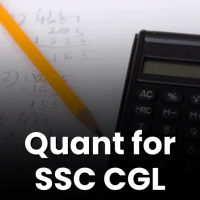Quant Exam > Quant Questions > ABCD is a square drawn inside a square PTRS o...
Start Learning for Free
ABCD is a square drawn inside a square PTRS of sides 4 cm by joining midpoints of the sides PR, PT, TS, SR. Another square is drawn inside ABCD similarly. This process is repeated infinite number of times. Find the sum of all the squares.
- a)16 cm2
- b)28 cm2
- c)32 cm2
- d)Infinite
Correct answer is option 'C'. Can you explain this answer?
Verified Answer
ABCD is a square drawn inside a square PTRS of sides 4 cm by joining m...
If we write the infinite series of area of squares:
= 42 + (2√2)2 + 22 + ……. infinite
Since it is a decreasing series sum of infinite terms can be approximated.
= 16 + 8 + 4 +………infinite
Most Upvoted Answer
ABCD is a square drawn inside a square PTRS of sides 4 cm by joining m...
To solve this problem, we can start by visualizing the squares being drawn inside each other.
Let's first consider the outer square PQRS. Its side length is 4 cm.
1. First iteration:
When we draw the first square inside PQRS by joining the midpoints of the sides, we get a smaller square with side length half of PQRS, which is 2 cm.
2. Second iteration:
Now, let's consider the square drawn inside the first square. Its side length would be half of the previous square, which is 1 cm.
3. Third iteration:
Continuing this process, we can see that the side length of the square drawn inside the second square would be half of the previous square, which is 0.5 cm.
4. Infinite iterations:
As we continue this process infinitely, the side length of the squares will approach 0, but never actually reach 0.
To find the sum of all the squares, we can use the concept of an infinite geometric series.
The sum of an infinite geometric series with first term a and common ratio r (|r| < 1)="" is="" given="" by="" the="" formula:="" />
Sum = a / (1 - r)
In this case, the first term a is 4 cm (the side length of the outer square) and the common ratio r is 1/2 (since each square has half the side length of the previous square).
So, the sum of all the squares can be calculated as:
Sum = 4 / (1 - 1/2)
= 4 / (1/2)
= 4 * 2
= 8 cm²
However, we have to be careful here. The sum we calculated above only includes the squares that have side lengths greater than 0. As we mentioned earlier, the side length of the squares approaches 0 but never actually reaches 0.
To account for this, we need to consider the limiting case as the side length tends to 0. In this case, the sum of the squares would approach the area of the outer square.
Since the area of the outer square is 4 cm * 4 cm = 16 cm², the sum of all the squares is 16 cm².
Let's first consider the outer square PQRS. Its side length is 4 cm.
1. First iteration:
When we draw the first square inside PQRS by joining the midpoints of the sides, we get a smaller square with side length half of PQRS, which is 2 cm.
2. Second iteration:
Now, let's consider the square drawn inside the first square. Its side length would be half of the previous square, which is 1 cm.
3. Third iteration:
Continuing this process, we can see that the side length of the square drawn inside the second square would be half of the previous square, which is 0.5 cm.
4. Infinite iterations:
As we continue this process infinitely, the side length of the squares will approach 0, but never actually reach 0.
To find the sum of all the squares, we can use the concept of an infinite geometric series.
The sum of an infinite geometric series with first term a and common ratio r (|r| < 1)="" is="" given="" by="" the="" formula:="" />
Sum = a / (1 - r)
In this case, the first term a is 4 cm (the side length of the outer square) and the common ratio r is 1/2 (since each square has half the side length of the previous square).
So, the sum of all the squares can be calculated as:
Sum = 4 / (1 - 1/2)
= 4 / (1/2)
= 4 * 2
= 8 cm²
However, we have to be careful here. The sum we calculated above only includes the squares that have side lengths greater than 0. As we mentioned earlier, the side length of the squares approaches 0 but never actually reaches 0.
To account for this, we need to consider the limiting case as the side length tends to 0. In this case, the sum of the squares would approach the area of the outer square.
Since the area of the outer square is 4 cm * 4 cm = 16 cm², the sum of all the squares is 16 cm².

|
Explore Courses for Quant exam
|

|
Question Description
ABCD is a square drawn inside a square PTRS of sides 4 cm by joining midpoints of the sides PR, PT, TS, SR. Another square is drawn inside ABCD similarly. This process is repeated infinite number of times. Find the sum of all the squares.a)16 cm2b)28 cm2c)32 cm2d)InfiniteCorrect answer is option 'C'. Can you explain this answer? for Quant 2025 is part of Quant preparation. The Question and answers have been prepared according to the Quant exam syllabus. Information about ABCD is a square drawn inside a square PTRS of sides 4 cm by joining midpoints of the sides PR, PT, TS, SR. Another square is drawn inside ABCD similarly. This process is repeated infinite number of times. Find the sum of all the squares.a)16 cm2b)28 cm2c)32 cm2d)InfiniteCorrect answer is option 'C'. Can you explain this answer? covers all topics & solutions for Quant 2025 Exam. Find important definitions, questions, meanings, examples, exercises and tests below for ABCD is a square drawn inside a square PTRS of sides 4 cm by joining midpoints of the sides PR, PT, TS, SR. Another square is drawn inside ABCD similarly. This process is repeated infinite number of times. Find the sum of all the squares.a)16 cm2b)28 cm2c)32 cm2d)InfiniteCorrect answer is option 'C'. Can you explain this answer?.
ABCD is a square drawn inside a square PTRS of sides 4 cm by joining midpoints of the sides PR, PT, TS, SR. Another square is drawn inside ABCD similarly. This process is repeated infinite number of times. Find the sum of all the squares.a)16 cm2b)28 cm2c)32 cm2d)InfiniteCorrect answer is option 'C'. Can you explain this answer? for Quant 2025 is part of Quant preparation. The Question and answers have been prepared according to the Quant exam syllabus. Information about ABCD is a square drawn inside a square PTRS of sides 4 cm by joining midpoints of the sides PR, PT, TS, SR. Another square is drawn inside ABCD similarly. This process is repeated infinite number of times. Find the sum of all the squares.a)16 cm2b)28 cm2c)32 cm2d)InfiniteCorrect answer is option 'C'. Can you explain this answer? covers all topics & solutions for Quant 2025 Exam. Find important definitions, questions, meanings, examples, exercises and tests below for ABCD is a square drawn inside a square PTRS of sides 4 cm by joining midpoints of the sides PR, PT, TS, SR. Another square is drawn inside ABCD similarly. This process is repeated infinite number of times. Find the sum of all the squares.a)16 cm2b)28 cm2c)32 cm2d)InfiniteCorrect answer is option 'C'. Can you explain this answer?.
Solutions for ABCD is a square drawn inside a square PTRS of sides 4 cm by joining midpoints of the sides PR, PT, TS, SR. Another square is drawn inside ABCD similarly. This process is repeated infinite number of times. Find the sum of all the squares.a)16 cm2b)28 cm2c)32 cm2d)InfiniteCorrect answer is option 'C'. Can you explain this answer? in English & in Hindi are available as part of our courses for Quant.
Download more important topics, notes, lectures and mock test series for Quant Exam by signing up for free.
Here you can find the meaning of ABCD is a square drawn inside a square PTRS of sides 4 cm by joining midpoints of the sides PR, PT, TS, SR. Another square is drawn inside ABCD similarly. This process is repeated infinite number of times. Find the sum of all the squares.a)16 cm2b)28 cm2c)32 cm2d)InfiniteCorrect answer is option 'C'. Can you explain this answer? defined & explained in the simplest way possible. Besides giving the explanation of
ABCD is a square drawn inside a square PTRS of sides 4 cm by joining midpoints of the sides PR, PT, TS, SR. Another square is drawn inside ABCD similarly. This process is repeated infinite number of times. Find the sum of all the squares.a)16 cm2b)28 cm2c)32 cm2d)InfiniteCorrect answer is option 'C'. Can you explain this answer?, a detailed solution for ABCD is a square drawn inside a square PTRS of sides 4 cm by joining midpoints of the sides PR, PT, TS, SR. Another square is drawn inside ABCD similarly. This process is repeated infinite number of times. Find the sum of all the squares.a)16 cm2b)28 cm2c)32 cm2d)InfiniteCorrect answer is option 'C'. Can you explain this answer? has been provided alongside types of ABCD is a square drawn inside a square PTRS of sides 4 cm by joining midpoints of the sides PR, PT, TS, SR. Another square is drawn inside ABCD similarly. This process is repeated infinite number of times. Find the sum of all the squares.a)16 cm2b)28 cm2c)32 cm2d)InfiniteCorrect answer is option 'C'. Can you explain this answer? theory, EduRev gives you an
ample number of questions to practice ABCD is a square drawn inside a square PTRS of sides 4 cm by joining midpoints of the sides PR, PT, TS, SR. Another square is drawn inside ABCD similarly. This process is repeated infinite number of times. Find the sum of all the squares.a)16 cm2b)28 cm2c)32 cm2d)InfiniteCorrect answer is option 'C'. Can you explain this answer? tests, examples and also practice Quant tests.

|
Explore Courses for Quant exam
|

|
Signup for Free!
Signup to see your scores go up within 7 days! Learn & Practice with 1000+ FREE Notes, Videos & Tests.


















